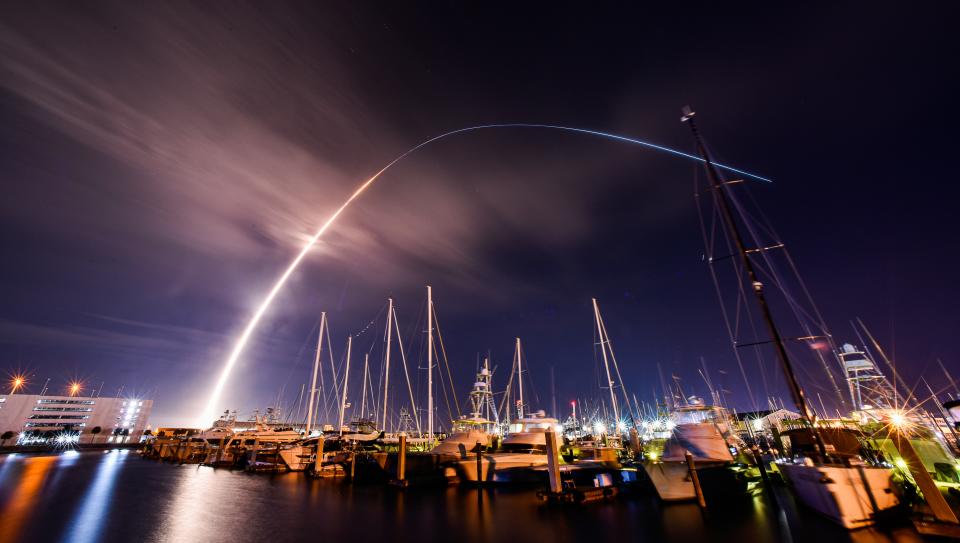ULA Vulcan rocket launches on history-making maiden flight from Florida: Watch liftoff
BREVARD COUNTY, Fla. − United Launch Alliance's new red-and-white Vulcan rocket lifted off in the early Monday morning darkness directly on time during its maiden flight from Cape Canaveral Space Force Station in Florida, propelling the Peregrine robotic lunar lander to its planned Feb. 23 moon landing.
"It was so exciting. I ran outside so I could watch this thing lift off. And that was so cool, after so many years of development, to watch this thing fly," Eric Monda, who works on ULA's mission design team, said 10½ minutes after liftoff on NASA TV.
"That was fantastic," Monda said.
The Vulcan's inaugural Cert-1 mission headlined a back-to-back Space Coast launch. SpaceX sent a Falcon 9 into low-Earth orbit at 5:35 p.m. EST Sunday from Launch Complex 40, and the rocket deployed another batch of 23 Starlink internet satellites into low-Earth orbit. Eight hours and 43 minutes later, the ULA Vulcan took flight at 2:18 a.m. Monday from nearby Launch Complex 41.
"Vulcan is very much based on our heritage rockets, the Delta IV and Atlas V vehicles. But we brought in a lot of new innovation and capabilities that are going to allow us to even better support our warfighters (and) exploration, as well as connecting the world," Amanda Bacchetti, ULA director of vehicle upgrades, said during the NASA TV broadcast.
More: Viewer's guide: ULA's Vulcan rocket aims for historic maiden liftoff early Monday morning
Watch rocket launch replay
What is the Peregrine Mission One?
Pittsburgh-based Astrobotic and its Peregrine Mission One is one of two NASA-supported private companies racing to get the U.S. back on the moon this year.
It will take Astrobotic two weeks to get to the moon and another month in lunar orbit before a landing is attempted on Feb. 23.
Astrobotic's Peregrine lunar lander is carried on the United Launch Alliance's new Vulcan Centaur rocket along with a variety of scientific instruments developed by NASA.
The uncrewed commercial missions are a vital part of NASA's hopes of sending astronauts back to the lunar surface itself within the next few years as part of its Artemis program.
Human remains also on board
The lunar lander and Vulcan Centaur rocket aren't the only cargo en route to the moon.
Two private companies, Celestis and Elysium, have also hitched a ride aboard the lunar lander for the cremated human remains and DNA of its customers destined for a cosmic burial. Among them are notable names that include “Star Trek” creator Gene Roddenberry and science fiction writer Arthur C. Clarke.
Another 265 people are represented on the rocket’s upper stage, which will circle the sun once separated from the lander. They include three original “Star Trek” cast members, as well as strands of hair from three U.S. presidents: George Washington, Dwight D. Eisenhower and John F. Kennedy, the Associated Press has reported.
However, the inclusion of remains on the moon mission elicited pushback from leaders of United States' largest tribe of Native Americans. Buu Nygren, president of the Navajo Nation, requested the launch window to be delayed, adding that the "sacredness of the moon is deeply embedded in the spirituality and heritage of many Indigenous cultures, including our own."
'A profound desecration': Navajo Nation asks NASA to delay moon mission with human remains
Peregrine lunar lander
Astrobotic's Peregrine four-legged lunar lander measures 6.2 feet tall and 8.2 feet wide. Equipped with a top-mounted solar panel, it will operate for about 10 days on the moon's surface with an array of scientific instrumentation.
"The United States hasn't soft-landed on the moon since NASA's Apollo program more than 50 years ago. And only a handful of countries have ever successfully landed on the lunar surface," Alivia Chapala, Astrobotic director of marketing and communication, said on NASA TV.
"Astrobotic's aim is to not only return the American flag to the moon again with Peregrine, but also to start regular commercial lunar deliveries to the moon's surface," Chapala said.
More private collaborations to come?
The upcoming mission, the first launch of the Vulcan Centaur, represents the debut of NASA's Commercial Lunar Payload Services program.
With a budget of $2.6 billion in contracts available through 2028, the program will see NASA more often partnering with private companies to help place scientific payloads on the lunar surface, freeing the space agency up to focus on building spacecraft and rockets for deep space missions.
What's next for Vulcan?
Next, ULA officials are targeting April for Vulcan's second flight to earn certification to carry Space Force national security payloads. Afterward, Bacchetti said engineers will embark upon about two months' worth of data testing before earning certification.

Rick Neale is a Space Reporter at FLORIDA TODAY (for more of his stories, click here.) Contact Neale at 321-242-3638 or rneale@floridatoday.com. Twitter/X: @RickNeale1
Eric Lagatta covers breaking and trending news for USA TODAY. Reach him at elagatta@gannett.com
This article originally appeared on Florida Today: ULA Vulcan launch: Watch liftoff of Peregrine Mission One to moon

